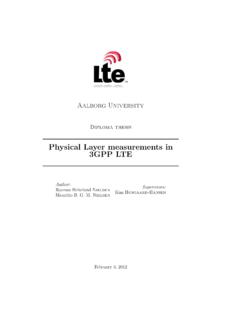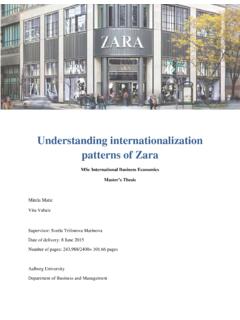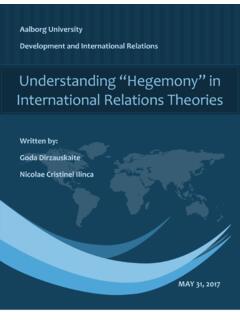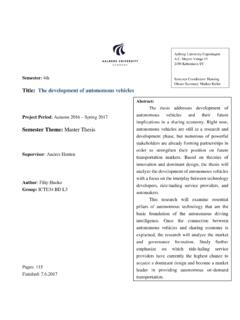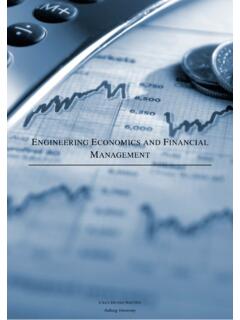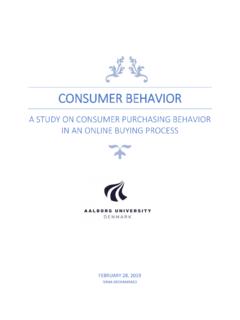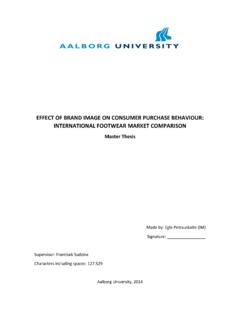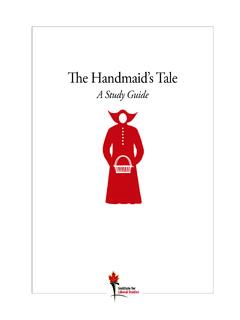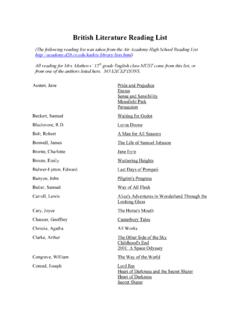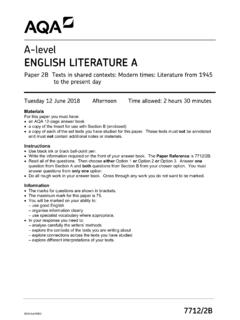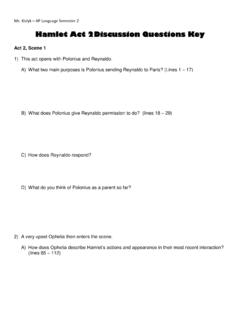Transcription of Feminist Theory and Feminist Literary Criticism: An ...
1 Feminist Theory and Feminist Literary Criticism: An Analysis of Jane Eyre and The Handmaid s Tale Camilla V. Pheiffer & Maiken S. Myrrh j Professor Mia Rendix Master s Thesis in English 3 June 2019 Summary In this thesis, we analyse how women are portrayed in two novels penned over a century apart using mainly Feminist Theory and Feminist Literary criticism. By gathering a historical context regarding feminism and describing the ideas and theories by H l ne Cixous, Robin Lakoff, Simone de Beauvoir and Judith Butler, we have been able to analyse Charlotte Bront s Jane Eyre from 1847 and Margaret Atwood s The Handmaid s Tale from 1985.
2 In our comparative analysis of the two novels, we discovered that they had several similarities despite being written over a century apart. Both novels portray a society in which women are the inferior gender and religion plays a dominant part. Both main characters represent ordinary women in their respective societies, and they are both restricted in terms of opportunities, actions and even their language, which makes them feel imprisoned. Furthermore, by discussing the theorists personal bias and reflecting on our choices, we identified the advantages and disadvantages of using newer Theory on older works of literature and using different types of theories.
3 We have been able to discuss the possibilities and limits of Feminist Literary criticism. As a result of this, we concluded that we are able to analyse older works thoroughly based on the terms, ideas, and methods introduced with newer theories. In addition, we concluded that using different types of theories can broaden your analysis, and it turns out that the theories are interwoven, which makes it evident to connect them in an analysis. However, we face the risk of over-analysing and applying Theory and meaning that was not indented in the first place, which is why we must be cautious in our argumentation.
4 Myrrh j & Pheiffer 1 Table of Contents Introduction .. 3 Theory .. 4 Feminism .. 4 Waves of Feminism .. 6 Women s Writing .. 10 criture feminine .. 10 The Laugh of the Medusa by H l ne Cixous .. 13 Language and Woman s Place by Robin Lakoff .. 19 Gender: Women s role and conditions .. 22 The Second Sex by Simone de Beauvoir .. 22 Gender Trouble by Judith Butler .. 25 30 Jane Eyre .. 30 Equality, Society and Gender .. 30 Religion .. 53 Women s Writing .. 58 The Handmaid s Tale .. 64 Equality, Society and Gender.
5 64 Religion .. 91 Women s Writing .. 97 Myrrh j & Pheiffer 2 Comparative Analysis and 104 Discussion .. 111 Personal Bias .. 111 Reflection and Critical View on the Theories .. 123 Conclusion .. 130 Works Cited .. 134 Myrrh j & Pheiffer 3 Introduction Throughout history, a major focus within feminism has been on the inequality between the genders in their respective society. What are the reasons for this inequality and who is to blame? This is a question feminists and philosophers have attempted to answer since the early 1800s, after French philosopher Charles Fourier coined the term feminism in 1837.
6 Since then, feminism has developed into Theory and to what is now known as Feminist Literary criticism. It is a Literary criticism like any other, but its perspective is feminism. When applying Feminist Literary criticism to a text, one can discover a female narrative supported by its characters, themes, etc. It is through this specific Literary criticism that one is able to deconstruct female characters and the way in which texts portray them. Furthermore, because of our contemporary knowledge regarding the history of feminism, we can apply the contemporary society and its social roles of the time in which a text was written.
7 One of the major works within feminism is the novel Jane Eyre by Charlotte Bront (1847). The novel contains criticism regarding religion, society and social roles. While the novel was written before the term feminism was coined, it is nevertheless considered a Feminist novel. Another Feminist work that recently attracted attention is the novel The Handmaid s Tale by Margaret Atwood (1985). Like Jane Eyre, The Handmaid s Tale contains criticism regarding religion, society and social roles. Despite being written 138 years apart, they share similarities within their criticism, which is one of the reasons for choosing these two novels.
8 In 1949, French Feminist and philosopher Simone de Beauvoir wrote her book The Second Sex, which discusses women s inferiority throughout history and how women are considered to be the other. In 1975, American Feminist and linguistics professor Robin Lakoff wrote her book Language and Woman s Place, where she discusses and analyses the relationship between gender and language. Also in 1975, French Feminist and philosopher Myrrh j & Pheiffer 4 H l ne Cixous wrote her essay The Laugh of the Medusa , in which she discusses criture feminine and encourages women to write themselves in order to reclaim their body.
9 In 1990, American Feminist and philosopher Judith Butler wrote her book Gender Trouble: Feminism and the Subversion of Identity, where she states that gender is socially constructed, and she introduces her term gender performativity . All four feminists and their theories share a common focus on women s role within society. This thesis focuses on Feminist Theory and Feminist Literary criticism, and the analysis takes up a dominant part of the thesis. Including an historical overview of feminism and an account of the prominent Feminist theories, this thesis analyses how the two novels/authors portray women within their respective societies, and their conditions, role and place by primarily using Feminist Literary criticism.
10 Thereafter, we discuss the similarities and differences between the two novels in a comparative analysis and discussion. We furthermore discuss how the portrayals of women in the novels compare to the periods in which they were written. Lastly, we examine the context in which the theories were written and discuss the significance thereof. We also discuss the possibilities and limits of Feminist Literary criticism, and the pros and cons of including different types of theories when analysing a Literary work. Theory Feminism The term feminism is unfortunately associated with extremists and man-haters.
